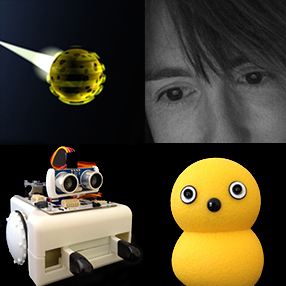Yesterday I went to visit Jessica Field, a Canadian artist/roboticist at her studio in Montréal.
Jessica has been building robots for more than ten years, and has an exhibit in the Communicating Vessels: New Technologies and Contemporary Art exhibition I mentioned in the previous post. A video of this work, in which three static robots: Alan, Clara, Brad and Daphne interact with one another to “watch” and “discuss” the movements of their visitors. A video explaining this work is available online. I went to visit these robots on Tuesday, and again today (Thursday). I saw Jessica in between, and mentioned that Clara didn’t seem to be saying much. I suspect that some maintenance work may have taken place, because today both Alan and Clara were working well, and I had fun moving about the space in front of them, in particular moving close to Clara’s “eyes”, which provoked an interesting reaction. You have to spend time with these robots in order to see how they interact, and the problems that they experience in communicating with one another. They “see” the world in very different ways, and cannot therefore agree on what is happening around them.
Jessica is now working on a new set of four robots, three of which can move around a sort of robot play-pen. As far as I am aware these robots do not yet have names, but they do have clearly defined characteristics and different levels of personality. The static robot reacts to sounds it “hears” with its two ears. If a sound reaches both ears then it switches on a light while the sound continues. If it only “hears” with one ear, then it moves around orienting itself to the sound. One of the moving robots can show either a phototropic or photophobic response, and it moves appropriately. As it does this is draws a line on the ground. Another moving robots follows lines it finds on the ground, and when it reaches the end of a line it stops, and “tells” you what it has read with sound. It then becomes attracted to sound, and will move towards this until it finds another line and reverts to line following. The third moving robot follows light in a more “intelligent” way than the robot with a hard wired response. It considers it’s movement, and moves more smoothly. However, I didn’t see this robot in action as it was in parts on Jessica’s desk!
As you can probably tell from the description above, these four robots are designed to form a robot ecosystem. They interact with one another, and also, to a certain extent, with their visitors when they follow sound.
Although I took photos of these robots it’s not appropriate for me to post them here. These robots are Jessica’s work in progress, and are being prepared for exhibit in January. As Jessica works on the robots she keeps a book of observations. These include scientific information about the circuit diagrams and programming of the robots, but also textual descriptions, stories and narratives based on her observations of the robots.
These robots are going to be presented in tandem with a video. This will take the form of what sounds like a “nature programme” about the robots and how they behave. This video is actually going to overstate what the robots are capable of doing, and Jessica is interested to see how visitors then understand the actual movements and behaviours of the robots in the installation.

